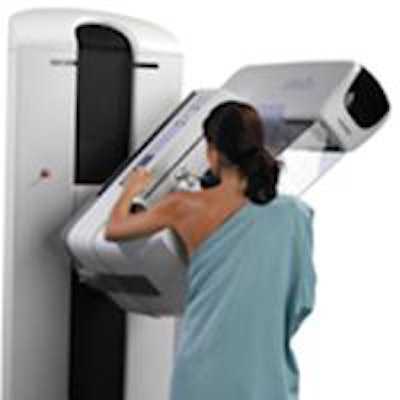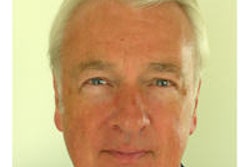
Using 3D digital breast tomosynthesis (DBT) with conventional 2D mammography finds 50% more cancers than 2D imaging alone and also reduces the false-positive rate, according to a new study published online April 25 in Lancet Oncology.
The combination of digital breast tomosynthesis and 2D mammography identified 8.1 cancers per 1,000 screens, compared with 2D mammography's 5.3 per 1,000 screens, an increase in the cancer detection rate of 53%, reported a team of Italian and Australian researchers.
In addition to higher sensitivity, the group found that the combination of 3D and 2D mammography lowered the recall rate, with 73 false-positive recalls versus 2D mammography's 141 (Lancet Oncology, April 25, 2013).
The study provides further evidence that the combination of 2D and 3D mammography could be used as part of a population screening program -- but only after further research has been done to monitor patient outcomes, according to lead author Stefano Ciatto, PhD, and colleagues.
"We hope that our work might be the beginning of a new chapter for mammography screening," Ciatto's team wrote. "Our findings should encourage new assessments of screening using 2D and 3D mammography."
Study protocol
For the study, 7,292 women were screened with Hologic's Selenia Dimensions digital breast tomosynthesis system between August 2011 and June 2012 in Trento and Verona, Italy. The mammograms were first interpreted using 2D mammography and then with integrated 2D and 3D mammography.
The group assessed the number of cancers detected overall, the number of cancers detected per 1,000 screens, the number and percentage of false-positive recalls, and the incremental cancer detection rate that could be attributed to the combination of 2D and 3D screening.
 Selenia Dimensions digital breast tomosynthesis system. Image courtesy of Hologic.
Selenia Dimensions digital breast tomosynthesis system. Image courtesy of Hologic.
A total of 59 cancers were found in 57 women. Two-thirds of the cancers detected (39, or 66%) were found in both 2D and combination 2D and 3D screening, but a third of cancers (20, or 33%) were missed on 2D screening alone and only detected in the combination mode, according to the authors.
The results were as follows:
- 5.3 cancers per 1,000 screens on 2D mammography alone
- 8.1 cancers per 1,000 screens on 2D plus 3D mammography
- An incremental cancer detection rate increase from the combination modality of 2.7 cancers per 1,000 screens
"There was consistent evidence of an incremental improvement in detection from integrated 2D and 3D mammography across age-group and breast density strata," the group wrote.
Fewer false positives
Another benefit of the 2D and 3D mammography combination was a reduction in the false-positive recall rate. There were 395 false positives; the overall rate for any recall that resulted in either true- or false-positive screens was 6.2%, while the false-positive rate for women who did not have breast cancer was 5.5%.
But combining 2D and 3D mammography improved the false-positive recall rate from 2% for 2D mammography alone to 1% for 2D and 3D. The recall rate for both 2D and the 2D/3D combination was 2.5%.
The team also calculated a theoretical false-positive rate based on a conditional approach that would only recall women if they had a positive result on integrated 2D and 3D mammography.
"Had a conditional recall rule been applied, we estimate that the false-positive rate would have been 3.5% and could have potentially prevented 68 of the 395 false positives [for a] reduction of 17.2%," they wrote.
What about radiation dose? The average dose a woman receives from 3D mammography alone is roughly equal to what she receives from 2D alone, according to the researchers. Using integrated 2D and 3D means that a woman is exposed to two acquisitions in one breast compression, which doubles the radiation dose -- which means further research is needed.
"Integrated 2D and 3D mammography for population screening might only be justifiable if improved outcomes were not defined solely in terms of improved detection," the team wrote. "For example, it would be valuable to show that the increased detection with integrated 2D and 3D screening leads to reduced interval cancer rates at follow-up."
In sync with Oslo
The study is the first population breast cancer screening trial of integrated 2D and 3D mammography to report its results, Ciatto's group wrote; however, the findings are consistent with the Oslo Breast Cancer Screening Trial (conducted under the Norwegian Breast Cancer Screening Program), results of which were published in Radiology (January 7, 2013).
That trial screened women with both 2D and 3D mammography but used randomized reading strategies (mammograms with 3D and without) and adjusted for different readers, while this study kept the same reader for each exam.
These two screening trials provide evidence that integrated 2D and 3D mammography screening could be used as part of population screening, provided that screening outcome measures are carefully monitored, according to the researchers.
"What is remarkable is the general consistency between our findings and those of the interim results of the Oslo study," co-author Dr. Nehmat Houssami, PhD, from at the University of Sydney School of Public Health in Australia, told AuntMinnie.com via email. "Both studies show that adding DBT to standard mammography significantly increases cancer detection rates."
Mammography screening may be controversial, but no matter which side of the debate one supports, clinicians need to investigate techniques that improve its quality and therefore its benefits, according to the team. Although the study results show that integrated 2D and 3D mammography in population breast screening increases detection of breast cancer and can reduce false-positive recalls depending on the recall strategy, the findings don't warrant an immediate change in breast cancer screening practice, Houssami said.
"Our results show the urgent need for randomized, controlled trials of integrated 2D and 3D versus 2D mammography, and for further translational research in breast tomosynthesis," she told AuntMinnie.com. "We anticipate that additional evidence will become available from other large screening studies in the near future, such as the Malmö Breast Tomosynthesis Screening Trial in Sweden and the TOMMY trial in the U.K., as well as the final results of the Oslo trial."



















